Choose a model to see more information about it. Clicking on a film type will bring you to the specific page for that type. |
|
|---|---|
Model 95A "Speedliner" |
|
Model 95B "Speedliner" |
|
Model 100 "One Hundred" |
|
Model 110 "Pathfinder" |
|
Model 110A "Pathfinder" |
|
Model 110B "Pathfinder" |
|
Rollfilm Cameras
The following technical information is useful for specifics concerning each model. Where appropriate you can click to see more information including photos.
All of these models can take 40 series films.
Please see this chart to give you a visual comparison between the major "options" and abilities of each rollfilm model.
Production Estimates provided are based on statistical observation (from accumulated reports of serial numbers recorded from actual cameras), and are not intended or expected to have perfect accuracy. Numbers in parentheses indicate "soft" limits, numbers not in parentheses indicate "hard" limits.
Example: Estimated Production: 800,000 - (900,000)
This means that there almost certainly has to have been at least 800,000 of that model made, but there probably were fewer than 900,000 made (but beware that there still could be more). Keep in mind that numbers are subject to change as new data is collected.
Produced: 1948-1953 / Original Retail: $89.75
Estimated Production: 800,000 - (900,000)
- Lens: 135mm, f/11, 3-element glass.
- Shutter: 4 speed everset rotary-leaf design; 1/8 - 1/60, plus Bulb.
- Flash: M-sync via ASA-bayonet post connector.
- Exposure set by Light Value scale. ("Polaroid numbers")
- Folding viewfinder, with simple "ball-and-mast" parallax compensation device.
- Scale focus, with distance set by arcuate lever.
- Has two tripod sockets and cable-release socket.
- Polished steel body with brown fake-leather covering. Some examples have chrome plated trim.
Important firsts: First Polaroid Land camera, first commercially successful self-developing camera system.
Note 1: Earlier examples of this camera was made for Polaroid by Samson United of Rochester, with the lens made by Wollensak (?) (Later models have bodies and lenses made by Polaroid themselves-- this was a stopgap solution until Polaroid could set up their own manufacturing line). A visitor reports that some Model 95's may have also been produced in a Timex plant in Atlanta.
Note 2: Unlike later Polaroid rollfilm camera models, the 95 has a pair of clips in the film chamber to hold the "negative" roll in place.
Collector's Notes: Certain details of this camera underwent minor changes during the overall production run. The most well-known of these is the fact that most of them (the first 700,000 or so that were produced) have a flexible spring post on the front standard (for viewfinder centering and parallax correction), whereas the later production models (the remaining 1 or 2 hundred thousand or so) have a rigid post instead. Also, the front nameplate was changed a few times as well. The first 100,000 or so 95's have an engraved nameplate with black ink used to fill in the engraved areas. The nameplate on the later production models is silkscreened (in black ink) instead. In addition, the first 300,000 or so have the word "FLASH" (engraved or silkscreened) around the ASA flash contact on the front, but this label does not appear on later-production 95's.
One interesting thing I have noticed is that the number (and selection) of patents identified inside the back of the camera changed several times during the production life of this camera. [Fun Do-It-Yourself Research Project: Get an old Polaroid camera. Now go to the United States Patent Office web site (www.uspto.gov). Look up the various patent numbers listed inside the camera. Fun eh? Notice that many of the design concepts described/illustrated in the patent applications for some of the early Polaroid camera patents are surprisingly different from the products which actually got made/sold.]
Incidently, despite the historic significance of this camera, there is very little demand for this camera in the USA from a collector perspective. In part, this is probably due to its relative commonness-- there were close to a million Model 95's produced during its production life.
Produced: 1954-1957 / Original Retail: $89.75
Estimated Production: 500,000
Similar to the Model 95 except:
- Lens: 130mm, f/8.8, 3-element glass.
- Shutter: 4 speed everset rotary-leaf design; 1/12 - 1/100, plus Bulb.
- Flash: M-sync via ASA post, X-sync via a special bi-pin connector.
- Folding viewfinder, with collapsible manually-set wire frame parallax compensation device (instead of the flip-up post in the 95).
- Film release push-button switch replaced with (more 'fool-proof') flip-style switch
- Polished steel body with brown fake-leather covering.
Note: Some Model 95A cameras may have some chrome-plated trim.
Produced: 1957-1961 / Original Retail: $94.50
Estimated Production: 230,000 - (300,000)
Similar to the Model 95A except:
- Exposure set by standard EV (Exposure Value) numbers rather than "Light Value" numbers.
- Later production models have extra seals for light-tightness when using 3000-speed film (identified by having the letter 'L' preceding the serial number) and slightly later ones yet also have a locking cutter bar.
Produced: 1954-1957 / Original Retail: $??.??
Estimated Production: Insufficient Data (probably < 10,000)
Similar to the Model 95A except:
- Special commercial/industrial model; modified heavy-duty shutter and rollers, and (possibly) lens made to stricter tolerances.
- Polished steel body with black or grey(?) textured covering
- Was also originally available as part of a complete kit for making ID pictures.
Note: Not to be confused with the far more common "Automatic 100" packfilm camera, which is an entirely different model.
Collector's Note: Very Uncommon. All of the (few) examples of this camera that I've seen have a covering that is black in color. I've heard said that a grey version may also exist, but I've never seen any real evidence to support this.
Produced: 1952-1957 / Original Retail: $249.50
Estimated Production: 14,000 - (21,000)
- Lens: 127mm, f/4.5, 4-element Wollensak Raptar
- Shutter: Wollensak Rapax, 1 - 1/400, plus Bulb and Time
- Flash: M,X sync via a bi-pin sync connector
- Folding viewfinder, with collapsible manually-set wire frame parallax compensation device
- Coupled Kalart rangefinder mounted on top of body next to viewfinder
- Focus knob on camera bed
- Top of rangefinder has an exposure calculator for converting Polaroid "Light Value" numbers to/from equivalent conventional shutter speed and aperture settings.
- Polished steel (and/or chromium) body with black textured covering
Note: Early production models have a pushbutton film release switch and film spool clips as in the original Model 95; later models have the flip-style switch for the film release as in the 95A and later cameras. In addition, some examples of this camera have some chrome-plated trim rather than plain base metal. The presense of chrome plating would seem to be random, however, and does not appear to correspond consistently to cameras of particular serial number ranges.
Produced: 1957-1960 / Original Retail: $169.50
Estimated Production: 92,000 - 100,000
Quite a bit different than the Model 110:
- Lens: 127mm, f/4.7, 4-element Rodenstock Ysarex. (other variations exist)
- Shutter: Prontor SVS, 1 - 1/300 plus Bulb. (other variations may exist)
- Flash: M,X sync via a standard PC connector and Polaroid "hot shoe"
- Exposure set either by conventional speeds/apertures, or by EV numbers.
- Built-in self-timer. ("V" setting on shutter)
- Double-window viewfinder/rangefinder on top of camera, with automatic parallax compensation (similar to Model 150).
- Focus knob on camera bed.
- Polished steel body with grey textured covering
- Hinged 'captive' lens cap. Late production models have an f/90 "pinhole" in the lens cap. This alternate lens cap was also available from Polaroid as a retrofit for earlier 110A's, so its presense shouldn't be taken as a sure sign of the camera's age.
- Late production models have extra light seals (indicated by a serial number starting with the letter 'L') and slightly later ones yet also have a locking cutter bar.
Note: This camera is sometimes found with a different lens/shutter combination (i.e. an Ennit lens in a Prontor shutter). These variations may have only been offered in versions sold outside North America.
Produced: 1960-1964 / Original Retail: $172.50
Estimated Production: 27,000 - (35,000)
Similar to the Model 110A except:
- Single-window viewfinder/rangefinder on top of camera, with projected framelines and automatic parallax compensation.
- f/90 "pinhole" in lens cap.
- All 110B's have the locking cutter bar and extra light seals.

Produced: 1961-1965 / International Markets
Estimated Production: Insufficient Data; Pattern Not Determined
Similar to the Model 110A except:
- Made in Japan by Yashica for Polaroid Corporation; for international markets only
- Lens: 127mm, f/4.7, 4-element Yashinon.
- Shutter: Seikosha-SLV, 1 - 1/500 plus Bulb.
Note: This camera does not have (or need) the "pinhole" lens cap like the 110B (or late-production 110A's). Instead, the lens aperture itself provides extra stops of f/64 and f/90.
Produced: 1957-1960 / Original Retail: $109.95
Estimated Production: 310,000 - (400,000)
Similar to the Model 95B except:
- Flash: M-sync via Polaroid "hot shoe," X-sync via a special bi-pin connector.
- Double-window viewfinder/rangefinder on top of camera, with automatic parallax compensation.
- Focus knob on camera bed
- Polished steel body with grey textured covering
- Early production models have a plain cutter bar. Later exampleshave extra light seals, and slightly later ones yet also have a locking cutter bar. The presense of the extra light seals can be determined by looking for the letter 'L' in front of the serial number.

Produced: 1962-1965 / International Markets
Estimated Production: Pattern Not Determined (over 70,000; could be much much more)
Similar to the Model 150 except:
- Made in Japan by Yashica for Polaroid Corporation; for international markets only
- Has permanently lubricated roller bearings
Notes: A strange thing about the 160 is that the camera's body is just like the 150 but the screw-hole that the focusing mirror uses is the same diameter as the 110B/900 mirror post. Making this a candidate for easy finder swapping without needing to drill and tap.
Also the "leather" covering seems to be some sort of vinyl that is harder to remove that normal coverings; weird Asian glue perhaps?
Produced: 1955-1957 / Original Retail: $125.00
Estimated Production: 24,000 - (35,000)
Similar to the Model 95A except:
- Uncoupled Kalart rangefinder mounted on top of camera next to viewfinder
- Polished steel body with green-grey "reptile-texture" covering like the 800.
Collector's Note: Uncommon.
Produced: 1957-1962 / Original Retail: $126.00
Estimated Production: 525,000 - (650,000)
Similar to the Model 150 except:
- Has permanently lubricated roller bearings and (supposedly) special high-precisionlens.
- Polished steel body with light tan textured covering.
Produced: 1961-1963 / Original Retail: $139.95
Estimated Production: 50,000 - (80,000)
Similar to the Model 150 except:
- Shutter: electrically controlled, 1/12 - 1/600, plus Bulb
- Automatic programmed exposure by CdS cell; manual control also possible by EV settings.
- Focus by wheel on edge of bed, shutter release on end of bed.
- Polished steel body with light tan textured covering.
Collector's Note: Significantly less common than the similar Model 900.
Produced: 1960-1963 / Original Retail: $159.95
Estimated Production: 460,000 - (650,000)
Similar to the Model 850 except:
- Has single-window viewfinder/rangefinder with projected framelines and automatic parallax compensation.
- Polished steel body with grey textured covering
Important First: First electrically-controlled shutter, first camera with programmed (shutter and aperture) auto exposure (?).
Produced: 1961-1963 / Original Retail: $89.50
Estimated Production: Pattern not entirely known (over 900,000; could be a lot more)
- Lens: 114mm f/19 or f/14.5 meniscus (single-element) plastic
- Shutter: pneumatic rotary; 1/15 - 1/1000
- Flash: built-in hinged tilt-out flashgun for AG-1 bulbs Flashgun can be rotated and pivoted to provide either bounce or direct flash.
- Automatic exposure; shutter speed controlled by selenium cell; manual control not possible.
- Designed only for use with 3000-speed (B&W) film, though a color adapter kit (#660) was made available later in the product's life.
- Flip-up viewfinder with projected framelines
- Simple two-position zone focus.
- Self-erecting bellows on scissor struts; no bed.
- Polished steel body with grey textured covering.
Notes: The shutter mechanism on this camera is rather unusual in design, and consists of a slitted rotating disc which is controlled by a pneumatic cylinder. The meter cell controls a vane which in turn regulates the flow of air from the cylinder, thus allowing for a range of shutter speeds. The mechanism used in the J66 and J33 cameras is also similar to that used in the #440 Photoelectric Shutter accessory that was available for most of the other Polaroid rollfilm cameras.
There are three different minor revisions of this camera; these can be differentiated by checking the color of the extra dot on the Lighten/Darken control ring. The 'yellow dot' cameras are the original ones from before 1962, and these allow for a maximum aperture of only f/19. This is probably the most common version of the three. The two later versions have blue and green dots respectively, and allow for a maximum aperture of f/14.5. I'm not sure what the difference between the 'blue dot' and 'green dot' cameras is, but it apparently has something to do with the flash exposure system.
Collector's Note: Probably the most common camera in this group. This was a very popular camera at its time-- it wasn't particularly versitile, but it was easy to use, had a built-in flashgun, and was somewhat less expensive than its brandmate at the time.
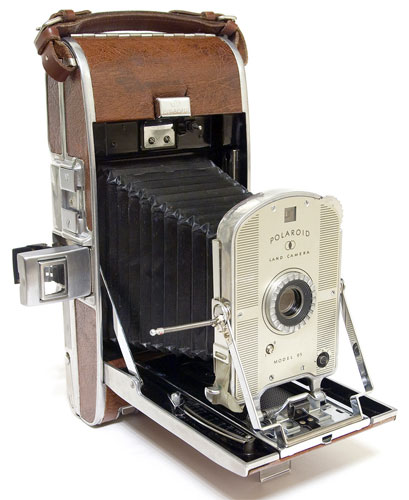
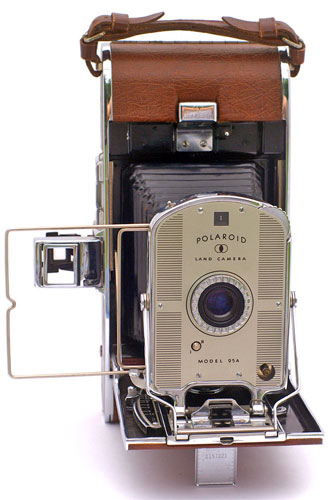

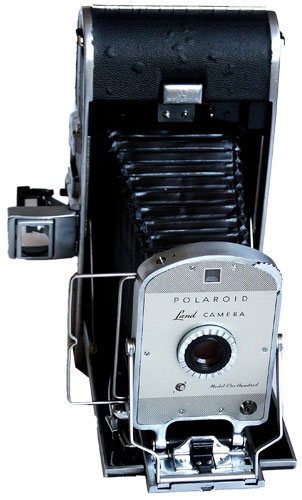
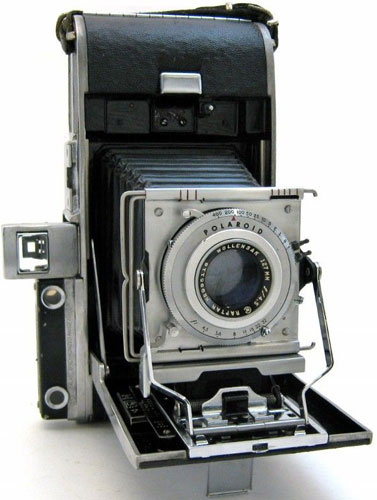
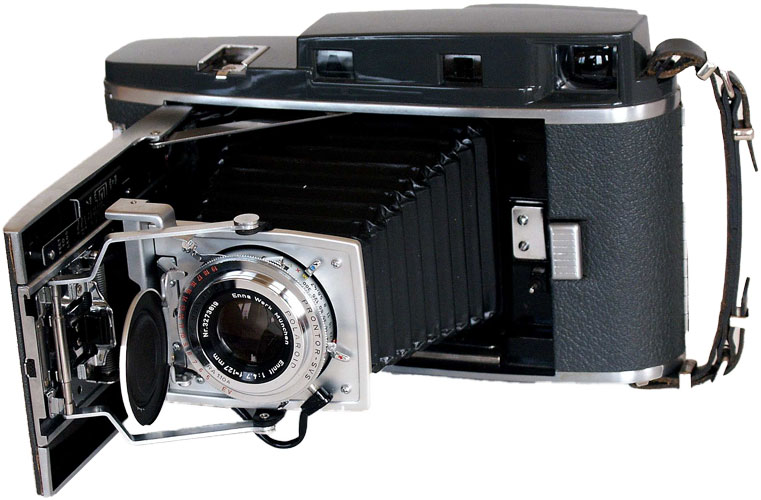
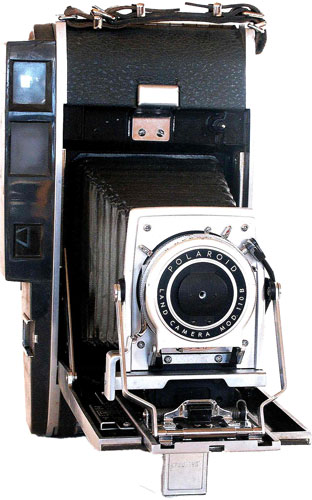
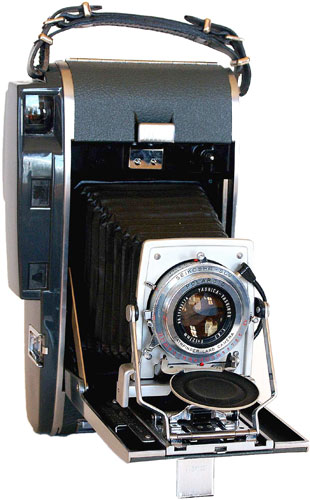
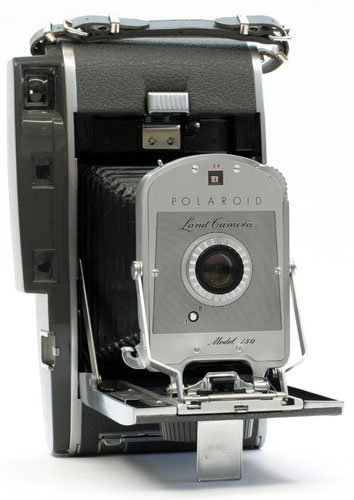
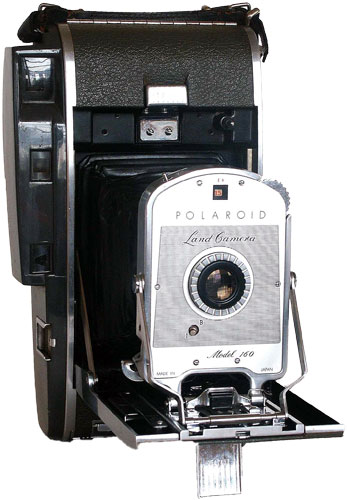
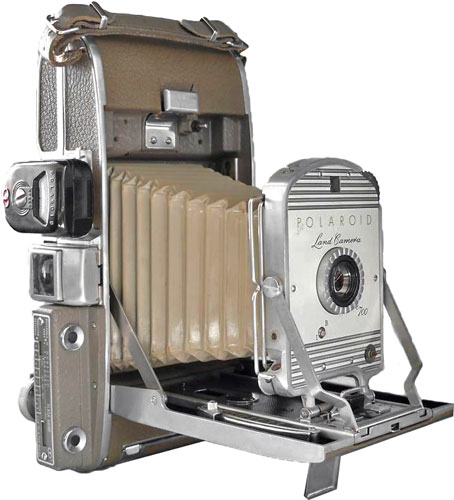
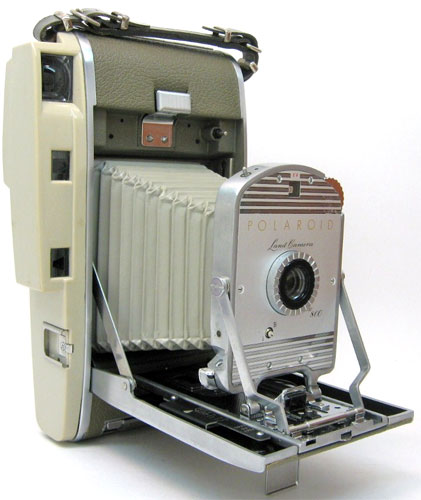


Option-al Landlist
Rollfilm
Cameras
Accessories
Film
Packfilm
Cameras
Accessories
Film
SX-70
Cameras
Accessories
Film
600/779
Cameras
Accessories
Film
Spectra
Cameras
Accessories
Film
Oddballs
Cameras
Accessories
Film
Polavision
Cameras
Accessories
Film
All Films
All Cameras
All Accessories
The FAQ
Contact me…